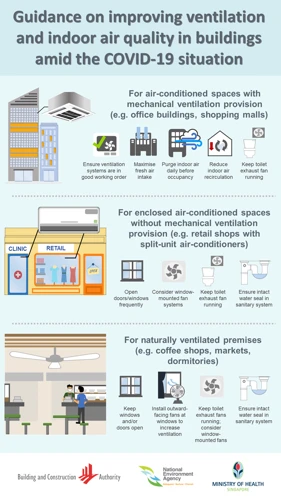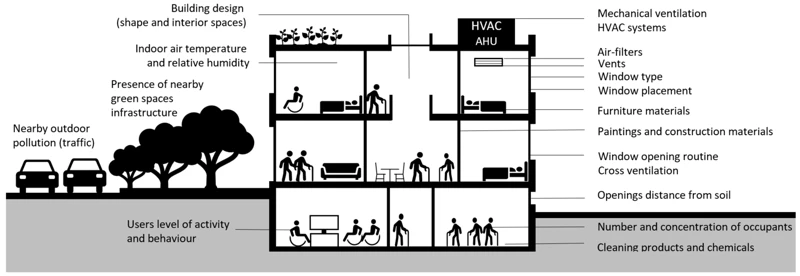The significance of indoor air quality cannot be overstated, as it directly impacts the health and comfort of building occupants. A key element in maintaining a healthy indoor environment is effective ventilation. The systems designed to cycle air in and out of buildings play a crucial role in diluting and removing contaminants.
The Role of Ventilation Systems in Maintaining Indoor Air Quality
Ventilation systems are engineered to introduce fresh air, circulate it within spaces, and exhaust stale air to the outside. By doing so, they reduce the accumulation of air pollutants, moisture, and odors. The efficiency of these systems is pivotal in ensuring that residents and workers alike are provided with a steady supply of clean air.
Scientific Approach to Ventilation: How Science Guides Best Practices
Science has a profound impact on the development of ventilation strategies. Through rigorous testing and research, scientists determine the optimal rates of air exchange and the most effective designs for various environments. This scientific approach to ventilation ensures that industry standards evolve based on empirical evidence, leading to healthier living and working spaces.
Improving Air Quality with Paint Choices
When it comes to enhancing the indoor atmosphere, paint choices are more influential than one might think. Selecting the right paint can significantly contribute to improving air quality, thanks to advancements in paint technology and composition.
VOCs in Paint: What You Need to Know
Volatility Organic Compounds (VOCs) in paint are chemicals that vaporize at room temperature and can deteriorate air quality. These compounds can cause various health problems, and they are a primary concern for indoor environments. Choosing low-VOC or no-VOC paint options is a simple yet effective step in promoting better air quality.
Eco-Friendly Painting: Benefits and Options
Eco-friendly painting goes beyond just minimizing VOCs. It also encompasses the use of sustainable materials and production practices. The benefits of eco-friendly painting include a reduced environmental footprint and a healthier indoor space. Options range from natural paints to those with certifications for environmental standards.
Health Impacts of Air Quality
The air we breathe indoors can have immediate and long-term effects on our health. Poor air quality is linked to a range of health issues, from simple irritations to serious conditions.
Paint Fumes and Health: Why Ventilation Matters
Exposure to paint fumes can lead to headaches, dizziness, and respiratory issues. The impact on health is a clear indicator of why proper ventilation is necessary, especially during and after painting activities. Ensuring that these fumes are effectively ventilated can mitigate potential health risks.
Benefits of Proper Ventilation for Health and Well-being
Proper ventilation promotes a healthier environment by reducing the concentration of airborne contaminants. Benefits of proper ventilation include improved respiratory health, reduced allergen levels, and enhanced overall well-being. Sufficient ventilation is essential in creating a safe and comfortable indoor climate.
Strategies for Enhancing Air Quality
There are several strategies that can be implemented to enhance the quality of the air we breathe indoors. From technological solutions to best practices during maintenance tasks, each approach contributes to a cleaner air environment.
Air Purification Techniques for the Indoor Environment
Air purification techniques range from simple practices like increasing natural ventilation to using advanced air purifiers with HEPA filters. Incorporating plants that are known to improve air quality and maintaining clean HVAC systems are also part of a comprehensive air purification strategy.
Best Practices for Ventilating During Painting Projects
During painting projects, it’s crucial to maintain good ventilation to ensure that paint fumes are swiftly removed. Opening windows, using fans, and taking breaks to allow the area to air out are best practices that should be followed. If possible, painting during milder weather conditions can also facilitate better air exchange.
Monitoring and Managing Air Quality
Continuous monitoring is a proactive way to manage indoor air quality. By keeping track of the levels of various pollutants, one can take timely action to address any issues that arise.
Tools and Techniques for Air Quality Monitoring
Modern tools like indoor air quality monitors can detect a wide array of pollutants, including VOCs, particulate matter, and carbon dioxide levels. These devices can provide real-time data, allowing for immediate adjustments to ventilation systems or behaviors to improve the air quality.
Responding to Air Quality Issues: Proactive Measures
Responding to air quality issues requires a proactive stance. This could involve regular maintenance checks of ventilation systems, replacing air filters, or adopting more stringent cleaning protocols. Taking these measures can help prevent air quality from reaching levels that could negatively impact occupants’ health.
When undertaking any painting project, understanding the importance of ventilation during interior painting is crucial for maintaining good air quality and ensuring a safe environment. To complement this, having the right essential safety gear for spray painting is equally important to protect yourself from potentially harmful fumes and particles. Additionally, knowing how to organize your painting workspace safely can prevent accidents and enhance efficiency. These resources can guide you through the science of ventilation and air quality as it applies to painting projects, helping you create a safer and healthier space.
Conclusion
Indoor air quality is a vital consideration for the health and well-being of building occupants. Through a combination of well-designed ventilation systems, eco-friendly painting choices, and diligent air quality monitoring, we can create indoor environments that not only comfort us but also promote our health. Adopting a scientific approach to ventilation and air purification, being mindful of the products we use, and proactively managing the air we breathe indoors are all steps in the right direction towards a healthier, more sustainable living and working spaces.


